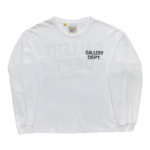The phrase “Art That Kills” is inseparable from the identity of Gallery Dept. It serves simultaneously as a design slogan, a creative manifesto, and a platform spun from the brand’s core. Josué Thomas, the founder behind Gallery Dept clothes, has used “Art That Kills” (often abbreviated ATK) to bridge his work in fashion, music, and visual art.
Beyond naming, “Art That Kills” captures a disruptive ethos: art should confront, provoke, and sometimes destroy norms. Gallery Dept channels this into clothing, treating garments as canvases that can be altered, distressed, reworked—and thus made more expressive than mere fashion pieces.
Visual Hallmarks: What Defines the Aesthetic
Paint Splatter, Brushstrokes & Hand-Finishes
One of the most recognizable traits across gallery dept clothes is the deliberate use of paint splatters, hand-applied brushwork, and uneven strokes. These visual “imperfections” evoke an expressive, workshop-studio energy, as though each garment has been individually treated.
Deconstruction, Distressing & Repair
Gallery Dept often begins with vintage or deadstock garments and intervenes with distressing, cuts, re-stitching, patchwork, or visible repairs. This approach leans into the wabi-sabi sensibility of beauty in imperfection.
Text & Slogan Motifs
Slogans—especially “Art That Kills” or “ATK”—feature prominently as graphic statements. These are printed, sometimes intentionally misaligned or layered, reinforcing the brand’s rebellious message.
Tie-Dye, Color Bleeds & Gradients
In some collections, tie-dye and color bleed techniques appear, complementing the hand-rendered visuals. These soften the starkness of black-and-white graphics and evoke a DIY aesthetic.
Layered Imagery & Collage
Many pieces layer multiple visual sources—photographic prints, abstract elements, text overlays—creating a collage effect. The result feels raw, energetic, and unpredictable.
Conceptual Underpinnings: Why “Kills”?
The provocative wording “Art That Kills” isn’t literally about violence or death. Instead, it suggests disruption—killing complacency, killing convention, or killing the boundary between art and utility. In Thomas’s vision, clothing becomes a medium: each piece is art in motion, meant to challenge how we view garments and self-expression.
This aligns with how the brand blends mediums. The ATK imprint has musical releases, visual art, merch, and fashion. The boundary between gallery exhibition, album release, and clothing drop is purposefully blurred.
Why It Resonates: Cultural & Market Factors
Artistic Authenticity & Scarcity
In a saturated streetwear space, individuality is prized. The hand-finished, one-of-a-kind variations in gallery dept clothes accentuate authenticity. No two pieces are perfectly identical.
Heritage & Reclamation
By working with vintage garments and reworking them, Gallery Dept taps into nostalgia, sustainability, and an ethos of reclamation. This gives the clothes narrative depth and value.
The Intersection of Art, Music & Fashion
Thomas’s presence in multiple creative spheres—music, visuals, and fashion—allows the “Art That Kills” aesthetic to feel holistic, not simply decorative. It’s a lifestyle brand as much as a clothes label.
Exclusivity & Hype
Limited drops, restocks, and the mystique of variation drive demand. The “Art That Kills” slogan acts as a hallmark of membership in a certain aesthetic tribe.
Challenges & Critiques
While the “Art That Kills” aesthetic has been praised, some critiques are worth noting. First, the labor intensity and handwork make scale difficult—hence the high price tags. Second, when replication or overuse of effects (paint splatter, slogans) occurs without fresh vision, there’s a risk of formulaic repetition. Third, the boundary between genuine artistic intervention and “art-washed” branding is thin; some see ATK as marketing more than philosophy.
Nonetheless, the brand seems aware of those tensions—Thomas has emphasized that ATK is a creative platform more than a merch line, using it to bridge art, music, and fashion.
How to Recognize Genuine Aesthetic Integrity
If you’re evaluating gallery dept clothes or ATK pieces, keep in mind:
- Surface texture & layering: authentic pieces often show multiple layers of paint and wear, not overly uniform or perfect.
- Variation & inconsistency: if two supposedly identical items look exactly the same, that may be suspect.
- Source garments: many originals use vintage or deadstock blanks, not mass-produced new items.
- Slogan placement & print quality: the print may look distressed or deliberately off-kilter.
- Context: pieces tied to ATK releases often carry deeper cultural or artistic background.
Conclusion
The “Art That Kills” aesthetic is Gallery Dept’s signature language—a blending of wearables and visual resistance. Through paint, distressing, collage, and slogan, each garment becomes an act of defiance against the ordinary. The brand’s capacity to span art, music, and fashion gives it cultural weight, and gallery dept clothes serve as canvases for that layered identity. As fans and observers explore this visual code, the landscape of high-end streetwear continues to expand toward the expressive and the experimental. In a world where niche craftsmanship commands premium status, the boundary-pushing narratives of Chrome Hearts apparel stand as another parallel in that rarefied dialogue between artistry and fashion.

